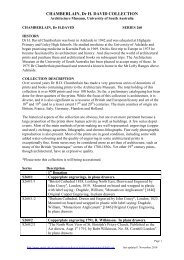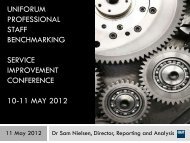GALLERY - University of South Australia
GALLERY - University of South Australia
GALLERY - University of South Australia
You also want an ePaper? Increase the reach of your titles
YUMPU automatically turns print PDFs into web optimized ePapers that Google loves.
SASA<br />
<strong>GALLERY</strong><br />
8 August - 31 August 2007
Artists:<br />
Di Barrett, Program Director: Visual Arts, SASA, UniSA<br />
Greg Donovan, Program Director: Graduate Diploma/Master <strong>of</strong> Visual Art<br />
& Design, Coordinator International Students, SASA, UniSA<br />
Andrew Hill, Portfolio Leader: Teaching & Learning, SASA, UniSA<br />
Mark Kimber, Studio Head: Photography & New Media, SASA, UniSA<br />
Toby Richardson, Lecturer, Photography, SASA, UniSA<br />
Olga Sankey, Program Director: Visual Arts Honours, SASA, UniSA<br />
Editor: Mary Knights, Director, SASA Gallery, UniSA<br />
Catalogue Design: Visual Communication Honours, SASA, UniSA,<br />
Shane Keane, BVC, UniSA & Ryan Smith, BVC, UniSA<br />
Catalogue Essays:<br />
Jim Moss, Senior Lecturer, Visual Art History & Theory, SASA, UniSA<br />
Dr Anne Marsh, Associate Pr<strong>of</strong>essor <strong>of</strong> Theory, Associate Dean<br />
Research, Faculty <strong>of</strong> Art & Design, Monash <strong>University</strong><br />
Front cover design: Shane Keane and Ryan Smith
Mark Kimber, SUN and MOON PICTURE 2, 2007, Giclée print<br />
2
5<br />
7<br />
13<br />
17<br />
Contents<br />
Introduction<br />
Mary Knights<br />
Digital Phantoms: A Reality Check.<br />
Dr Anne Marsh<br />
Transmission<br />
Jim Moss<br />
Acknowledgements<br />
3
Toby Richardson, “What use do I have for it now my granddaughter has grown up”, Goodwood 5034, 2007, Giclée print<br />
4
Introduction<br />
Transmission is a group exhibition by members <strong>of</strong> the Digital Art Research Experiment (DARE) which was<br />
established to ‘investigate practices and boundaries around the evolution <strong>of</strong> digital media’. 1 This exhibition is the<br />
fifth in a series that invites external scholars, as well as local, interstate and international artists and designers, to<br />
participate in the SASA Gallery’s exhibition and publication programs. Dr Anne Marsh, Associate Pr<strong>of</strong>essor, Theory<br />
<strong>of</strong> Art & Design, Faculty <strong>of</strong> Art & Design, Monash <strong>University</strong>, is the external scholar participating in this exhibition.<br />
Her research areas include photography, feminism, postmodernism, psychoanalysis and performance art. Marsh<br />
has been published extensively in arts journals, exhibition catalogues and edited collections <strong>of</strong> essays and she is<br />
the author <strong>of</strong> Body and Self: Performance Art in <strong>Australia</strong>, 1969-1992 (Oxford <strong>University</strong> Press 1993) and<br />
The Darkroom: Photography and the Theatre <strong>of</strong> Desire (Macmillan 2003).<br />
Jim Moss is a lecturer in Art & Design History & Theory at the <strong>South</strong> <strong>Australia</strong>n School <strong>of</strong> Art (SASA). He has<br />
published a considerable number <strong>of</strong> catalogue essays and critical texts that engage with visual arts discourse, both<br />
historical and contemporary. Current interests include the resurgence in aesthetics which, Moss argues, has been<br />
largely generated by the digital colonization <strong>of</strong> imagery.<br />
The SASA Gallery supports a program <strong>of</strong> exhibitions focusing on innovation, experimentation and performance.<br />
With the support <strong>of</strong> the Division <strong>of</strong> Education Arts & Social Sciences, UniSA, and the Division Research<br />
Performance Funds, the SASA Gallery is being developed as a leading contemporary art space publishing and<br />
exhibiting high-quality research based work, and as an active site <strong>of</strong> teaching and learning. The SASA Gallery<br />
showcases <strong>South</strong> <strong>Australia</strong>n artists, designers, writers and curators associated with the <strong>South</strong> <strong>Australia</strong>n School<br />
<strong>of</strong> Art and the Louis Laybourne-Smith School <strong>of</strong> Architecture in a national and international context.<br />
Mary Knights<br />
Director, SASA Gallery<br />
1.<br />
DARE SASA Gallery exhibition proposal, 2006<br />
5
Greg Donovan, White As, 2007, synthetic polymer paint, digital print on German etching paper<br />
6
Digital Phantoms: A Reality Check. Dr Anne Marsh<br />
When Juliana Engberg directed the first Biennial <strong>of</strong> Contemporary Art<br />
in Melbourne (1999) she became famous for saying that “video was the<br />
tapestry <strong>of</strong> the twenty-first century”. The idea seemed to resonate with<br />
artists and the public alike and it is a way <strong>of</strong> conceptualising photo-based<br />
and electronic media that recognises the history <strong>of</strong> its evolution and<br />
underlines its provenance. There’s always talk about new media and<br />
<strong>of</strong>ten this noise tends to foreclose on history. Making a comparison<br />
between tapestry and video may seem a bit far fetched but what Engberg<br />
was getting at is that these forms <strong>of</strong> art and image making have a popular<br />
appeal, they are also functional and able to be adapted across different<br />
levels <strong>of</strong> skill. Tapestry was both a private, domestic form <strong>of</strong> image<br />
making and a public display <strong>of</strong> virtuoso talent. Today we can say the<br />
same about digital photography which allows the amateur operator to<br />
compete with pr<strong>of</strong>essionals.<br />
Zara Stanhope curated an exhibition at MoMA at Heidi recently – titled<br />
Perfect for Every Occasion: Photography Today – where the everyday<br />
and the street photograph re-surface in recent photo-based practice.<br />
Artists are consistently looking for new ways in which to challenge the<br />
mainstream, and, after a decade or so <strong>of</strong> spectacular, performative<br />
museum-sized photo prints, it comes as no surprise that artists once<br />
again search out the mundane and the ordinary and try to insert some<br />
sort <strong>of</strong> balance. Stanhope introduced her exhibition with a small suite <strong>of</strong><br />
photo-journalist shots - some taken by pr<strong>of</strong>essionals, some by amateurs,<br />
but all reproduced on a very small scale, as if clipped from a magazine.<br />
The artists in Perfect for Every Occasion are not photojournalists nor<br />
social documentary photographers in the traditional sense but many <strong>of</strong><br />
them look to street photography and the art <strong>of</strong> the everyday, including<br />
conceptual art, as a way <strong>of</strong> distancing themselves from performative or<br />
directorial photography.<br />
The accessibility <strong>of</strong> photography to a population <strong>of</strong> producers was<br />
made famous in George Eastman’s advertising slogan for Kodak in the<br />
1880s: “You push the button, we do the rest” became an emblematic<br />
slogan for photography’s utilitarian value. 1 This democratic aspect<br />
<strong>of</strong> the medium makes photography an amateur image making process<br />
which has enormous popular appeal. Although the mass production<br />
<strong>of</strong> millions <strong>of</strong> family snap shots has been analysed as a ‘middle brow art’<br />
by French sociologist Pierre Bourdieu, other critics have expanded on<br />
the psychological aspects <strong>of</strong> the medium that seduce the photographer<br />
and the viewer. 2<br />
There has been an increased interest in amateur photography in recent<br />
times. The most powerful digital images to infiltrate our electronic<br />
networks were the mobile phone camera pictures <strong>of</strong> Iraqi prisoners<br />
being tortured by American soldiers at Abu Ghraib. These images have<br />
shocked the world because we believe them to be true accounts <strong>of</strong> what<br />
happened. No amount <strong>of</strong> postmodern theory is going to convince us that<br />
these are inauthentic copies without an original experience.<br />
The digital age brings with it the potential to manipulate and invent<br />
images in new ways, using various s<strong>of</strong>tware packages and electronic<br />
interfaces to produce fantastic results. This world <strong>of</strong> fantasy and the<br />
phantasmagorical has a long and spectacular history that begins when<br />
people first started to gaze at the stars.<br />
Walter Benjamin suggests that the history <strong>of</strong> photography begins when<br />
people start to interpret the configurations <strong>of</strong> the night sky. 3 When they<br />
see pictures written in light. For Benjamin, “reading – and therefore the<br />
possibility <strong>of</strong> knowledge in general – begins in the reading <strong>of</strong> stars.” 4<br />
This is a compelling metaphor that propels Benjamin into meditations<br />
on philosophy and history. All reading and writing is interpretation, all<br />
languages are synthetic systems <strong>of</strong> one sort or another. What Benjamin<br />
and a host <strong>of</strong> artists are interested in is the mysterious side <strong>of</strong> this process.<br />
This is not to say that this is an a-political desire, on the contrary, it is a<br />
dialectical thinking that acknowledges that modes <strong>of</strong> mechanical and<br />
technological reproduction change the way in which ideology thinks<br />
and seduces. The phantasmagoria <strong>of</strong> modernity and post-modernity<br />
(shopping malls, advertising, the World Wide Web, photography, film,<br />
computer games and virtual worlds) enmesh the subject/spectator within<br />
a sophisticated techno-psychological experience, one in which the real has<br />
already become a simulacra. 5<br />
The most positive outcome <strong>of</strong> this era is that the subject/spectator<br />
becomes increasingly involved as an active participant, choosing and<br />
selecting one form or idea over another—supporting both established<br />
stereotypes and sub-cultural identities. For Benjamin, like the Surrealists,<br />
it was a matter <strong>of</strong> harnessing the powers <strong>of</strong> the phantasmagoria to the<br />
revolutionary struggle; using the phantasmagorical and dream elements<br />
to precipitate dialectical thinking.<br />
The meeting <strong>of</strong> art and science within mechanical and digital forms <strong>of</strong><br />
representation produces a discourse that is rich and multi-layered. On one<br />
hand analogue photography promised (scientifically) to reproduce what<br />
was in front <strong>of</strong> the camera’s lens. The photograph was to be an index <strong>of</strong><br />
7
8<br />
the real. However, because <strong>of</strong> human intervention, this real was always<br />
manipulated in some way. Framing, cropping or contextualising the real,<br />
was there from the very beginning: this was the way in which the stars<br />
were transformed into signs.<br />
Although many histories <strong>of</strong> the mechanical/digital image are grounded in<br />
the progress <strong>of</strong> technology as a means <strong>of</strong> analysing modes and styles, it is<br />
not the technology in itself that is captivating. It is the way in which the<br />
technologies are capable <strong>of</strong> exploring the meeting <strong>of</strong> magic and science,<br />
the way in which they engage us psychologically.<br />
It also needs to be noted that mechanisms, technologies, programmes,<br />
instruments and s<strong>of</strong>tware are all tools that have been designed to do<br />
particular things. The camera obscura, for example, was said to reproduce<br />
Renaissance perspectival space, a one point perspective which positioned<br />
the subject/spectator at the centre <strong>of</strong> the viewing experience. But the<br />
camera obscura is much older than the Renaissance, Helmut Gernsheim<br />
notes that: “The optical principle <strong>of</strong> the camera obscura images was<br />
known to Aristotle (384-322)”. 6 The scientific minds <strong>of</strong> the Enlightenment<br />
may have valued the camera for its indexical and mimetic qualities,<br />
however, it quickly became a very popular device. In the hands <strong>of</strong> the<br />
operator the camera obscura was a theatrical device, a darkroom, a mini<br />
stage upon which nature and culture converged.<br />
From the inception <strong>of</strong> cameras, there has always been a desire by<br />
practitioners and operators to stretch the limits and capacities <strong>of</strong> the<br />
instrument. Add to this the desire and the imagination <strong>of</strong> the operator<br />
and the spectator and one has an intricate map rich in metaphors which<br />
impact on belief, memory, history and psychology.<br />
Digital photography has been described as a kind <strong>of</strong> demon. A monster<br />
that annihilates the analogue and indexical qualities <strong>of</strong> the medium.<br />
These qualities were supposed to anchor photography to the real. The<br />
promise <strong>of</strong> photography, in the service <strong>of</strong> art and science, was that it<br />
would reproduce reality without the interception <strong>of</strong> the operator. The<br />
idea that nature did the work was exploded by the simple fact that<br />
humans pushed the button. The famous and relatively ‘innocent’ case <strong>of</strong><br />
the Cottingley Fairy photographs is just one example <strong>of</strong> the performative<br />
nature <strong>of</strong> the medium in the hands <strong>of</strong> children and at the whim <strong>of</strong> desire. 7<br />
This photographic hoax, like recent day UFO photographs, was spun out<br />
for years and given credibility by Arthur Conan Doyle, the author <strong>of</strong> the<br />
Sherlock Holmes mysteries. The point is that human intervention is bound<br />
to spoil science. In the realm <strong>of</strong> the visual, it’s predictable and endearing<br />
that humans would want to mess up.<br />
There has been a lot <strong>of</strong> debate about the status <strong>of</strong> the medium in art in<br />
recent years. A kind <strong>of</strong> hysteria emanating from the October group and<br />
Rosalind Krauss in particular. She fears that too much inter-media art and<br />
installation results in the disappearance <strong>of</strong> the medium. This seems<br />
to me to be strange from a scholar who championed “sculpture in the<br />
expanded field” and did so much to support the postmodern impetus<br />
in art which essentially undermined the medium as it had been described<br />
by the late modernists in America. Yet retrospectively both Krauss and<br />
Hal Foster, who now believes that design has infected the fine arts, have<br />
come to question the pluralism <strong>of</strong> postmodernism which they believe is in<br />
the service <strong>of</strong> global capital. 8 Thus those who once heralded a postmodern<br />
turn now turn away and impel artists to return to the essentials <strong>of</strong> the<br />
medium. To me this sounds like a retreat into high formalism, a return<br />
to the ivory tower where art and popular culture are safely separated.<br />
It also seems implausible, like a bid to stop time, to return to the glory<br />
<strong>of</strong> a safer formalist avant-garde enshrined by Clement Greenberg in<br />
the 1940s, and now by Rosalind Krauss who follows Greenberg in her<br />
allegiance to the medium. 9<br />
This tendency to retreat into the past cannot stem the flow <strong>of</strong> new<br />
media and technologies. The time <strong>of</strong> mediums is over in its formal sense.<br />
One must ask what is the medium <strong>of</strong> photography? Is it its analogue,<br />
indexical and empirical truth, which has come under so much scrutiny and<br />
criticism? Is it its filmic substance, those layers <strong>of</strong> skin that are stolen and<br />
saved? 10 And then one would ask: is it not the magic and mysticism <strong>of</strong> this<br />
process that is actually compelling rather than the thing in itself? Is it not<br />
the process that enchants us? The promises that fairies actually might be<br />
photographed? And, if this is the case, then surely what we are talking<br />
about is the desire to invent things that are improbable. And now in the<br />
twenty-first century the digital enters centre stage and says you can have<br />
all <strong>of</strong> this and more. The digital and electronic media disperse the concept<br />
<strong>of</strong> the medium. Each new media is predicated on the past but looks to the<br />
future, to new possibilities, new means <strong>of</strong> production and distribution.<br />
You push the button or click the mouse to invent your own fantasies.<br />
Make fairies, ghosts, UFOs; create heroes out <strong>of</strong> miniature models,<br />
crime scenes from ordinary suburban houses. Invest in your imagination,<br />
photoshop will do the rest.<br />
There is no going back to the medium as an essential entity but it is<br />
apparent throughout digital photo and lens-based practice that artists<br />
are looking to the past as much as to the future. Toy cameras and old<br />
technologies are <strong>of</strong>ten combined with digital means <strong>of</strong> presentation.<br />
My recent research suggests that the scanner, arguably a fairly mundane<br />
piece <strong>of</strong> equipment, is the tool that is used the most in photo-based<br />
production. 11 The scanner allows artists to scan almost anything (now<br />
even three dimensional objects) and to create enormous digital files which<br />
then allow the artist to print at scales unimaginable to the photographers<br />
<strong>of</strong> the 1970s. It also allows for the picture to be printed on virtually any<br />
surface. There’s nothing magical about a scanner, it’s essentially a copier.<br />
But it’s probably the most important conduit in the chain <strong>of</strong> production.<br />
Much like the simple modem that allows us to participate in the World
Di Barrett, Crucifiction III, 2007, archival photomedia on paper<br />
9
Olga Sankey, Forked Tongue (diptych), 2007, inkjet print and sand blasted perspex<br />
10
Wide Web. The modem itself is a fairly dumb piece <strong>of</strong> equipment<br />
but it opens the door to an incredible world <strong>of</strong> information sharing<br />
and mass distribution.<br />
The bid to return to the essentials <strong>of</strong> the medium <strong>of</strong> photography or<br />
painting or sculpture seems a retrograde step, one engineered to promote<br />
a return to formalism. It is at once nostalgic and a-political: a desire to<br />
return to a bygone time when things were less complicated and fashion<br />
and advertising, along with popular culture and design, were kept<br />
separate from the high arts. This is one <strong>of</strong> the greatest modernist myths.<br />
Other eras in history have championed the closing <strong>of</strong> the gap between<br />
art and life, between art and science, between design, art and<br />
architecture. The Gothic era, the Arts and Crafts Movement, the<br />
Bauhaus and arte povera spring to mind.<br />
The fear that installation art and new media arts will somehow poison<br />
the arts or detract from the main game is misplaced. We communicate<br />
in virtual spaces everyday. As soon as we have a telephone conversation<br />
or go on line we are in a virtual space. Furthermore, the idea <strong>of</strong> the<br />
virtual image is not new, it was imagined and written about early in the<br />
prehistory <strong>of</strong> photography. 12 Perhaps what is frightening for some people<br />
is that the concept <strong>of</strong> virtual reality has become a real phenomenon in<br />
today’s society. People regularly engage and perform in virtual spaces such<br />
as MySpace and You Tube where they can create identities for themselves.<br />
The idea <strong>of</strong> the real is slipping away and it makes some people nervous.<br />
The digital age ushers in new zones <strong>of</strong> contact and connection between<br />
people. The screen environment has become an intimate and personal<br />
environment for many people. Over 180,000,000 people have a presence<br />
on MySpace, a seemingly clean and safe arena for chat and making friends<br />
– friends that may not exist as they present. This new environment creates<br />
fear as does the taking <strong>of</strong> photographs in public spaces. Photography itself<br />
has become a kind <strong>of</strong> crime. The slash through icons once only aimed at<br />
smokers and drinkers are now accompanied by the slashed camera icon.<br />
We are in a rapidly changing environment where the photograph, after<br />
supposedly losing its indexical relationship to the real (via the digital), is<br />
now punished because the digital allows the real to be distributed in the<br />
instant <strong>of</strong> a second. This argument is somewhat contradictory. On one<br />
hand the digital is supposed to move away from the indexical, to mess<br />
with the essential medium <strong>of</strong> the photograph, its promise to represent<br />
the real; on the other hand the moral panic associated with photographs<br />
<strong>of</strong> children being electronically distributed is predicated on the idea that<br />
the photograph does represent the real. 13 This suggests that we haven’t<br />
moved as far away from the index as we may have thought. Despite<br />
the performative and manipulative qualities <strong>of</strong> the digital, many images<br />
still begin life in association with the real. This is most apparent in art<br />
photography where any degree <strong>of</strong> manipulation would be acceptable<br />
under the banner <strong>of</strong> creative licence. Contemporary photographers do<br />
utilise digital tools, but they haven’t turned their back on the object;<br />
like their colleagues before them, they usually start with the thing in<br />
front <strong>of</strong> the lens.<br />
1. Helmut Gernsheim, The Origins <strong>of</strong> Photography,<br />
10. For a discussion <strong>of</strong> the spectral spheres <strong>of</strong> the body<br />
London: Thames and Hudson, 1982, p. 116.<br />
and the ways in which photography might steal<br />
2. See Roland Barthes, Camera Lucida: Reflections on<br />
them, thus literally proposing death by photography<br />
Photography, trans. Richard Howard, London: Fontana, see: Nadar, ‘My Life as a Photographer’ (1900), and<br />
1984 (first published in French as La Chambre Claire, Rosalind Krauss, ‘Tracing Nadar’, October, no. 5,<br />
1980); Ge<strong>of</strong>frey Batchen, Burning with Desire: The<br />
Summer, 1978, pp. 7-28 and pp. 29-48. See also Susan<br />
Conception <strong>of</strong> Photography, Cambridge, Massachusetts: Sontag On Photography, pp. 158-160. It was probably<br />
MIT Press, 1997; Pierre Bourdieu, Photography: A<br />
Oliver Wendell Holmes who first wrote about ‘spectral<br />
Middle-Brow Art, Oxford: Polity/Basil Blackwell, 1990, spheres’ and photography, see ‘The Stereoscope and<br />
(first published in French 1965); Cadava, Eduardo,<br />
the Stereograph’ (1859) in Beaumont Newhall (ed.)<br />
Words <strong>of</strong> Light: Thesis on the Photography <strong>of</strong> History, Photography: Essays and Images, London: Secker and<br />
Princeton, New Jersey: Princeton <strong>University</strong> Press, 1997. Warburg, 1981, pp. 53-61.<br />
3. For a compelling analysis see Eduardo Cadava, Words <strong>of</strong> 11. My research is on Contemporary <strong>Australia</strong>n Photography<br />
Light, pp. 26-30.<br />
since 1980 and will result in a searchable website and a<br />
4. Eduardo Cadava, Words <strong>of</strong> Light, p. 28.<br />
book to be released in 2008.<br />
5. Jean Baudrillard, ‘The Precession <strong>of</strong> the Simulacra’, in 12. For a discussion <strong>of</strong> the virtual image in early<br />
Brian Wallis (ed.), Art After Modernism: Rethinking<br />
photography see Ge<strong>of</strong>frey Batchen, ‘Detours:<br />
Representation, New York: New Museum <strong>of</strong><br />
Photography and the Camera Lucida’, Afterimage,<br />
Contemporary Art, 1984, pp. 253-282.<br />
vol.18, no. 2, September 1990, p. 14.<br />
6. Helmut Gernsheim, The Origins <strong>of</strong> Photography, p. 7. 13.<br />
The issue <strong>of</strong> paedophiles utilising the World Wide<br />
7. Anne Marsh, The Darkroom: Photography and the<br />
Web is a huge social problem and I am not meaning<br />
Theatre <strong>of</strong> Desire, <strong>South</strong> Yarra, Victoria: Palgrave-<br />
to belittle this here. The interesting issues is that these<br />
Macmillan, 2003, pp. 164 and Susan Bright, Art<br />
producers are using digital and electronic means to<br />
Photography Now, London: Thames and Hudson,<br />
represent the real.<br />
2005, p. X.<br />
8. See Rosalind Krauss, ‘Sculpture in the Expanded<br />
Field’ in Hal Foster (Ed.) The Anti-Aesthetic: Essays on<br />
Postmodern Culture, Seattle, Washington, Bay Press,<br />
1983, pp. 31-42; ‘“. . . And Then Turn Away?” An Essay<br />
on James Coleman’, October, no. 81, 1993, pp. 5-33;<br />
‘A Voyage on the North Sea’: Art in the Age <strong>of</strong> the Post-<br />
Medium Condition, London: Thames & Hudson, 1999;<br />
and ‘Reinventing the Medium’, Critical Inquiry, winter,<br />
1996, pp. 289-305. Also Hal Foster, Design and Crime<br />
and Other Diatribes, London/New York, Verso, 2002.<br />
9. Kraus started her career as a formalist, preferring<br />
Greenberg’s approach to art criticism over Harold<br />
Rosenberg’s more romantic and literary approach. She<br />
was a close colleague <strong>of</strong> Michael Fried’s in the 1960s<br />
and an editor <strong>of</strong> Artforum during its formalist period.<br />
She later turned away from Greenberg and fell out<br />
with Fried but her recent insistence on the specificity <strong>of</strong><br />
the medium promotes a return to formalist concerns<br />
in contemporary criticism. For a lucid analysis see Amy<br />
Newman, Challenging Art: Artforum 1962-1974, New<br />
York: Soho Press, 2000.<br />
11
Mark Kimber, SUN and MOON PICTURE 56, 2007, Giclée print<br />
12
Transmission by Jim Moss<br />
The text below is in response to an invitation from the DARE group<br />
<strong>of</strong> artists to address their work in essay form for the catalogue <strong>of</strong> the<br />
exhibition Transmission. There’s always an element <strong>of</strong> risk in such an<br />
undertaking and one is never more conscious <strong>of</strong> this than when writing<br />
around the work <strong>of</strong> six artists. The common thread that has drawn the<br />
work <strong>of</strong> these artists together in this exhibition is the incorporation <strong>of</strong><br />
digital imaging technology in the construction <strong>of</strong> their work. All six<br />
artists were trained in pre-digital technologies in the areas <strong>of</strong> photography,<br />
printmaking, painting and drawing and each <strong>of</strong> them has adopted<br />
digital ways to facilitate specific requirements, from the technical to the<br />
conceptual. Thus, it has been around this common denominator that the<br />
writer has spun his words, sometimes focusing on cause and other times<br />
on effect and sometimes (but, with a greater degree <strong>of</strong> difficulty) on<br />
things in between.<br />
It is not, however, the role <strong>of</strong> the catalogue essayist to critique the work<br />
– that is for others to do. The role <strong>of</strong> the catalogue essay is to address the<br />
work in an expository manner as possible while also contributing to the<br />
textual ‘hum’ <strong>of</strong> the exhibition.<br />
Musing on the large images <strong>of</strong> mattresses by Toby Richardson the writer<br />
is reminded <strong>of</strong> the 15th Century Flemish masters and their obsession with<br />
details, particularly in their rendering <strong>of</strong> cloth and <strong>of</strong> the clothes worn by<br />
the personages in their paintings. Flanders gained much <strong>of</strong> its wealth from<br />
transforming English wool into cloth prior to sending it south to the dyers<br />
<strong>of</strong> Florence. Fine clothes were highly distinctive items in early renaissance<br />
Europe and the Flemish artists were in a league <strong>of</strong> their own when it came<br />
to rendering the materiality <strong>of</strong> cloth, furs and embroidery (and a range <strong>of</strong><br />
other commodities like books) with such exquisite verisimilitude that one<br />
cannot help thinking that herein such exactitude lay a primary purpose for<br />
the work. (A similar subtext can be gleaned from the ubiquitous presence<br />
<strong>of</strong> mathematical perspective in Italian painting <strong>of</strong> the same period).<br />
However, as the acquisition <strong>of</strong> verisimilitude signified a growing technical<br />
virtuosity in the case <strong>of</strong> the Flemish painters, it was also indexical <strong>of</strong> a<br />
cognitive shift in the ritualistic and symbolic order <strong>of</strong> things. In a manner<br />
not dissimilar to the way Flemish realism celebrated the commodity form<br />
in the age <strong>of</strong> Gutenberg, visual culture in the new digital age also appears<br />
to be in the thrall <strong>of</strong> an intense hyper realism.<br />
The digital aesthetic displays an overriding obsession with the replication<br />
<strong>of</strong> natural form, and in this it paradoxically demonstrates a return to a key<br />
concern <strong>of</strong> artists during the Renaissance: verisimilitude. Contemporary<br />
computers can simulate practically anything, to such an extent that it is<br />
becoming increasingly difficult to immediately distinguish between that<br />
which is real and its simulation. Verisimilitude has become the holy grail <strong>of</strong><br />
the Digital Age. 1<br />
Not to be confused with the super-realism <strong>of</strong> 1970’s painting, hyperrealism,<br />
like its Flemish antecedent, brings home the astonishing capacity<br />
<strong>of</strong> contemporary imaging technology to facilitate a new paranoid-critical<br />
discourse with reality. How is it that these almost life-size images <strong>of</strong><br />
mattresses in various stages <strong>of</strong> decomposition appear to us as a vision<br />
splendid? Why is it that used mattresses hung vertically against the wall<br />
would simply look drab or even abject? Well, simply because actual<br />
mattresses and these images <strong>of</strong> mattresses bear no relation to one<br />
another, The images are not made from the same material as mattresses;<br />
neither are they three dimensional and neither do the images have any <strong>of</strong><br />
the qualities <strong>of</strong> actual mattresses - other than that they are perfect visual<br />
simulations <strong>of</strong> actual used mattresses down to the microscopic detail <strong>of</strong><br />
their fabric structure with every stray fibre in exquisite delineation. These<br />
images are handsome, even beautiful, and they are faultless examples <strong>of</strong><br />
Roland Barthes’s famous dictum – A photograph is a message without a<br />
code: 2 codes obscure and give alternate readings, whereas the beauty <strong>of</strong><br />
these images lies in the pristine verisimilitude <strong>of</strong> their mattressness. And if<br />
it is the case, as Baudrillard has stated, that images murder the real, then,<br />
surely these are mattresses that have died and gone to heaven.<br />
Heaven is a place opposite to that where Olga Sankey would like to<br />
send authoritarian perpetrators <strong>of</strong> the word. As an artist, who has<br />
worked predominantly in the discipline <strong>of</strong> printmaking, Olga Sankey is as<br />
fascinated with the heritage <strong>of</strong> Gutenberg as she is with the heritage <strong>of</strong><br />
Albrech Dürer and for a number <strong>of</strong> years now Olga’s work has zeroed in<br />
on variations <strong>of</strong> the image/text relationship, a field that continues to <strong>of</strong>fer<br />
a wealth <strong>of</strong> deconstructive options.<br />
Her current work maintains a critical commentary on language or, more<br />
specifically, on our assimilation <strong>of</strong> the codes <strong>of</strong> language. In Forked<br />
Tongue written text is reduced to its semiotic essentials – the ‘Ur’ marks<br />
<strong>of</strong> children learning by rote hark back to narratives <strong>of</strong> authority that<br />
have been millennially sheeted home to a belief in and obedience to<br />
manifestations <strong>of</strong> the word - and the voice <strong>of</strong> the law first spoke from the<br />
interior <strong>of</strong> a burning bush and instructed Moses to lead the children <strong>of</strong><br />
Israel, the descendents <strong>of</strong> Abraham and Noah, out <strong>of</strong> captivity and into<br />
the promised land. However, while the children <strong>of</strong> Israel may have escaped<br />
the clutches <strong>of</strong> the Pharaoh, they were never to escape the omnipresence<br />
<strong>of</strong> their vengeful god.<br />
13
14<br />
And so it is with all children: those <strong>of</strong> a certain generation can well<br />
remember the school black-board with its chalk simulations <strong>of</strong> copperplate<br />
script signifying not just the ultimate in pristine literacy but the promise<br />
<strong>of</strong> perfection at the conjunction <strong>of</strong> obedience and knowledge.<br />
Verily... the promise <strong>of</strong> enlightenment has always been predicated on<br />
the acquisition <strong>of</strong> the word and it is on this specific issue that Olga<br />
Sankey, the visual artist, confronts the voodoo qualities <strong>of</strong> the word as<br />
it’s been conjugated in Judeo- Christian doctrine and makes a little<br />
mockery out <strong>of</strong> it.<br />
And for an artist who has worked primarily as a print maker, what<br />
does digital technology <strong>of</strong>fer compared with traditional printmaking<br />
technologies? Well, apart from providing a radically more efficient<br />
technology, digital also facilitates the acquisition <strong>of</strong> and the layering <strong>of</strong><br />
imagery, greater precision and more intense colours.<br />
It appears that, as Tennyson wrote in another context, …the old order<br />
changeth, yielding place to new and… gone are the arcane practices<br />
that hark back to the Middle Ages; the plates, the inks, the stones, the<br />
presses; the materiality that was printmaking. But not gone is the mystery<br />
<strong>of</strong> ancient things; after all, the lineage <strong>of</strong> digital s<strong>of</strong>tware can be traced<br />
to the origins <strong>of</strong> binary calculus in India a millennium before Christ. In<br />
place is another mystery – the mystery <strong>of</strong> transference from the materiality<br />
<strong>of</strong> things to the immateriality <strong>of</strong> things. The shift from the physical<br />
transference <strong>of</strong> information to the ideational transference <strong>of</strong> information,<br />
is a shift that is most marked in the digital transformation <strong>of</strong> printmaking.<br />
Di Barrett is particularly enthusiastic about the sheer scope <strong>of</strong> what<br />
s<strong>of</strong>tware has to <strong>of</strong>fer her photographic practice and doesn’t lament the<br />
passing <strong>of</strong> traditional ways. As a photographic artist Di’s career was honed<br />
on film stock and darkroom alchemy, but, photography is not a category<br />
that immediately springs to mind when viewing the Crucifiction images 1,<br />
11 & 111. Clearly, photographic images constitute the raw material <strong>of</strong> this<br />
work but the images have been ‘cooked’ 3 and re-constituted into surface<br />
arrangements <strong>of</strong> graphic intensity, heightened by a compositional tension<br />
between symmetry and chaos and a content dichotomy that fluctuates<br />
between the sacred and the pr<strong>of</strong>ane.<br />
What is consistent in this suite <strong>of</strong> work is the overall tenor <strong>of</strong> Judeo-<br />
Christian symbolism, the presence <strong>of</strong> which belies the less obvious fact<br />
that all three works are thematically quite inconsistent and what appears<br />
to be a symphony <strong>of</strong> repetition within each image are in fact variations on<br />
a theme, occasionally subverted by shards <strong>of</strong> ambiguity and discord.<br />
These works are in response to what the artist perceives as an increasing<br />
lack <strong>of</strong> spirituality in the world, while this writer would suggest they are<br />
also ‘about’ an incredulity with the sheer scope <strong>of</strong> what the s<strong>of</strong>tware<br />
has to <strong>of</strong>fer. Such a presumption suggests a digital path may lead to an<br />
increase in spirituality. And, why not? We are going to have to become<br />
more spiritual to save this planet and essence <strong>of</strong> digital may well be a<br />
crucial ingredient in a re-growth <strong>of</strong> our world.<br />
Another implication here is that while Di Barrett’s work is a response to<br />
a perceived lack <strong>of</strong> spirituality it’s not necessarily about that. It could be<br />
suggested that this work is no more about spirituality, or its lack, than<br />
is the Book <strong>of</strong> Revelations about Christianity. There are complex links, <strong>of</strong><br />
course, but they’re not the same stories.<br />
The title, Crucifiction, is common to all three images, with each displaying<br />
a variation on the sign <strong>of</strong> the cruciform but only one <strong>of</strong> which is a crucified<br />
figure. But is it He? The bottom left crucified figure in Crucifiction 11 has<br />
demonic qualities not shared by the other three. All four crucified figures<br />
share a somewhat blurred, ghostly presence against the finely chiselled,<br />
arcane symbolism. The trans-gendered Christ-like figures in ecstasy<br />
(and contraposto) from Crucifiction 111 float, suspended over a vista<br />
<strong>of</strong> black cruciforms that could be read as a rendering <strong>of</strong> a mother-board<br />
or matrix within which the ritual division <strong>of</strong> zeros and ones (female<br />
and male integers) may collude in the production <strong>of</strong> a third order <strong>of</strong><br />
phantasmic possibilities.<br />
The vicissitudes <strong>of</strong> the human condition are inscribed in more prosaic<br />
tones in the work <strong>of</strong> Andrew Hill, the emotional impact <strong>of</strong> which is<br />
facilitated through his appropriation <strong>of</strong> the building blocks <strong>of</strong> digital<br />
imagery – pixels. Pixels are the result <strong>of</strong> the extraordinary facility <strong>of</strong> digital<br />
imaging technology to store colours and tones in numerical sequences <strong>of</strong><br />
zeros and ones. When the ‘light picture’ is admitted through the aperture<br />
<strong>of</strong> a digital camera it strikes a chip that has a mega number <strong>of</strong> electronic<br />
nodes, each <strong>of</strong> which translates into numerical form a ‘byte’ <strong>of</strong> the colour<br />
and tone <strong>of</strong> the ‘light picture’. Each byte can be downloaded as a pixel<br />
that collectively construct an image and the more pixels in play the greater<br />
the verisimilitude <strong>of</strong> the image. However, unlike many digital imagemakers,<br />
Andrew emphasises the pixelated look <strong>of</strong> his images to the point<br />
where he actually makes painterly simulations <strong>of</strong> highly pixelated images.<br />
Painting pixelated images could be interpreted as a postmodern conceit,<br />
were it not for this artist’s discovery that pixels have, amongst other<br />
things, metaphorical qualities.<br />
The subjects <strong>of</strong> Andrew Hill’s photography and painting are refugees and<br />
other such victims who have been displaced and/or traumatised by wars<br />
and other conflicts. A visibly pixelated image <strong>of</strong>, say, a woman’s face can<br />
have an expressionistic quality as if the subject’s emotions are made visible<br />
in little packages, or quanta, <strong>of</strong> colours and tones, the jagged edges <strong>of</strong><br />
which signify emotional and physical stress, as if the realities <strong>of</strong> a<br />
person’s existence had started to fragment. Conversely, these images<br />
also bring to mind Jean Luc Goddard’s quip – This is not a just image,<br />
it is just an image.
Andrew Hill, Undefined, 2007, digital image<br />
15
16<br />
And just images they may well be, but as is the case with both the refugee<br />
subjects <strong>of</strong> this work and the work <strong>of</strong> the other artists in Transmission,<br />
these images occupy zones in between: between disciplines, between<br />
oeuvres and between realities.<br />
In the catalogue essay for an exhibition Mark Kimber: Sun Pictures in<br />
Sydney <strong>of</strong> this year, the writer, Amy Patterson, makes the observation<br />
that the images …recreate elusive visions half sighted out <strong>of</strong> the corner<br />
<strong>of</strong> the mind’s eye, apprehended in glimpses but never fully known. 4 The<br />
inference here is that the images can be read as psychically glimpsed<br />
alternatives to the generally perceived ubiquity and mundaneity <strong>of</strong> day<br />
to day visual experience. Indeed, the Sun Pictures shown in Transmission<br />
foreground relatively ordinary things from the urban landscape, an arena<br />
<strong>of</strong> pr<strong>of</strong>ound photographic potential into which the artist has only recently<br />
returned. 5 The urban landscape is, after all, an invention <strong>of</strong> photography<br />
- indeed, it has long been the promised-land <strong>of</strong> the photographic image,<br />
accommodating a range <strong>of</strong> genres amongst which the surreal ‘look’ has<br />
been omnipresent.<br />
And yet, Mark Kimber isn’t <strong>of</strong>fering some clichéd surrealist fare. While the<br />
collective sub-text <strong>of</strong> his Sun Pictures suggests the artist is keeping one eye<br />
cocked for an evocation <strong>of</strong> the marvellous, the images are encoded with a<br />
highly conscious sense <strong>of</strong> composition and authorship. Sun Picture #2 is<br />
a classic (a Smart!) quotation and is indicative <strong>of</strong> this photographer’s eye<br />
for spotting manifestations <strong>of</strong> art from amongst the detritus <strong>of</strong> the real.<br />
The artist best sums up his modus operandi – For me the compelling force<br />
that drives my work is finding a situation where the play <strong>of</strong> light, form and<br />
landscape converge in time and space to create an elusive and ephemeral<br />
piece <strong>of</strong> theatre. 6<br />
Given the possibilities inherent in digital editing s<strong>of</strong>tware, this<br />
photographer’s focus has shifted from the enquiring gaze <strong>of</strong> the latest<br />
Canon, et al, to ‘slumming it’ with a basic plastic camera, the single<br />
shutter speed <strong>of</strong> which is more analogous to the psychic glance. This<br />
minimalising <strong>of</strong> front-line equipment also privileges the photographer<br />
as the creative eye – indeed, in Sun Picture 2 Mark ‘appears’ as mise<br />
en scene in his own shadow. Additionally, the basic camera technology<br />
also provides a dark-room fix (for those apparatchiks weaned on film)<br />
before the negative is scanned and uploaded as electronic integers<br />
<strong>of</strong> zeros and ones.<br />
Digitally scanning an image prior to working it further is a technique<br />
also used by Greg Donovan. However, with this artist, a digital<br />
engagement is primarily a means to an end. Initially, Greg creates a<br />
first order image using traditional drawing and printmaking techniques,<br />
including image transfer. He then has the work digitally scanned and<br />
printed into a high resolution simulation <strong>of</strong> the original. Finally, in what<br />
might seem an act <strong>of</strong> faith, he again works back ‘into’ the digital image,<br />
re-appropriating its lost origins.<br />
While the artist’s authorial gesture reclaims the work in an ontological<br />
sense, it firmly locates digital technology as just another process or<br />
technique amongst a range <strong>of</strong> others. Simultaneously, however, the digital<br />
intervention renders the ‘original’ image superfluous; just another origin<br />
in a potential procession <strong>of</strong> origins. Consequently, the digital component<br />
is, inevitably, more than just another process in Greg Donovan’s imagery,<br />
but how do we gauge its presence? After all, it’s both visible and invisible.<br />
The absent presence <strong>of</strong> the digital image is, ironically, an analogy for<br />
what has been described as, …an endless cycle <strong>of</strong> the reduplication and<br />
overproduction <strong>of</strong> sign, images and simulations that leads to an implosion<br />
<strong>of</strong> meaning…(a) transformation <strong>of</strong> reality into images… 7<br />
Of particular concern to this artist is the manipulation <strong>of</strong> the real by media<br />
based infotainment and associated surveillance technologies and his<br />
images are …an attempt to reinterpret and undermine…the seductive and<br />
manipulative power <strong>of</strong> selective image production whilst reinstating the<br />
image as other than reportage. 8<br />
It may be, however, that we are now so locked into Baudrillard’s fourth<br />
stage <strong>of</strong> the image that attempts to undermine our counterfeit reality<br />
will remain just that –attempts (although, as apparent in the above,<br />
it has led to some interesting art). It may also be that the pleasure <strong>of</strong><br />
the simulacrum runs deep, evolutionarily deep. And if that’s the case,<br />
modern art’s resistance to technology’s appropriation <strong>of</strong> the real is<br />
one <strong>of</strong> the great resistance movements in history and will always be<br />
remembered as such.<br />
1. Marvel, L. The Digital Imaginary, Phot<strong>of</strong>ile 68, 2003<br />
2. Barthes, R. (trans. Stephen Heath) (1977),<br />
Image Music Text. P43<br />
3. William Gilpin, one <strong>of</strong> the three Englishmen who theorized<br />
the idea <strong>of</strong> the ‘picturesque’ used the term when<br />
commenting on the condition <strong>of</strong> nature - Nature is all very<br />
well but it needs to be cooked.<br />
4. Patterson, A. (2007) Catalogue Essay, Mark Kimber:<br />
Sun Pictures, Stills Gallery.<br />
5. Artist’s statement from Sun and Moon Pictures (2007)<br />
6. Ibid.<br />
7. Featherstone, M. (1995) Undoing Culture, Globalism,<br />
Postmodernism and Identity, SACE Publications, London.<br />
8. Artist’s statement from Distant Image-Surveillance (2007)
Acknowledgements<br />
Acknowledgements<br />
The Director, SASA Gallery, would like to acknowledge the contribution<br />
to the development <strong>of</strong> the 2007 SASA Gallery exhibition program by<br />
the SASA Gallery Advisory Committee and Exhibition Programming<br />
Committee; John Barbour, Portfolio Leader: Research & Postgraduate<br />
Degrees, SASA, UniSA; SASA Gallery staff; Pr<strong>of</strong>. Kay Lawrence, Head <strong>of</strong><br />
School, <strong>South</strong> <strong>Australia</strong>n School <strong>of</strong> Art, UniSA; Pr<strong>of</strong>. Drew Dawson, Dean:<br />
Research, Division <strong>of</strong> Education, Arts & Social Sciences, UniSA; and Pr<strong>of</strong>.<br />
Michael Rowan, Pro Vice Chancellor, Division <strong>of</strong> Education, Arts & Social<br />
Sciences, UniSA. The Director, SASA Gallery, thanks Tony and Connie Perrini<br />
for the generous support <strong>of</strong> the 2007 SASA Gallery exhibition program<br />
by Perrini Estate.<br />
The Director, SASA Gallery, thanks the artists Di Barrett, Greg Donovan,<br />
Andrew Hill, Mark Kimber, Toby Richardson and Olga Sankey; essay<br />
writers Anne Marsh and Jim Moss; and graphic designers Fred Littlejohn,<br />
Lynda Kay, Shane Keane and Ryan Smith and for their participation and<br />
involvement in this exhibition and catalogue.<br />
Published by the <strong>South</strong> <strong>Australia</strong>n School <strong>of</strong> Art (SASA) Gallery<br />
<strong>University</strong> <strong>of</strong> <strong>South</strong> <strong>Australia</strong><br />
Adelaide SA 5000<br />
August 2007<br />
ISBN 978-0-9803062-5-5<br />
Artists: Di Barrett, Greg Donovan, Andrew Hill, Mark Kimber,<br />
Toby Richardson & Olga Sankey<br />
Editor: Mary Knights<br />
Catalogue design: Lynda Kay & Shane Keane & Ryan Smith<br />
Printed by Cruickshank Printers<br />
SASA Gallery staff:<br />
Mary Knights, Director, SASA Gallery<br />
Louise Flaherty & Keith Giles, Gallery Administrative Assistants<br />
Mark Siebert & Marie Hodgeman, Gallery Assistants<br />
Julian Tremayne, exhibition installation and lighting consultant<br />
The exhibition, catalogue, visit by external scholar and associated events<br />
were developed by the <strong>South</strong> <strong>Australia</strong>n School <strong>of</strong> Art with the support<br />
<strong>of</strong> the Division Research Performance Fund; the Division <strong>of</strong> Education,<br />
Arts & Social Sciences, UniSA and Arts SA.<br />
Mark Kimber is represented by Greenaway Art Gallery, Adelaide,<br />
and Stills Gallery, Sydney; Toby Richardson is represented by Helen Gory<br />
Galerie, Melbourne; Olga Sankey is represented by Dianne Tanzer<br />
Gallery, Melbourne.<br />
17
Experience. The Difference


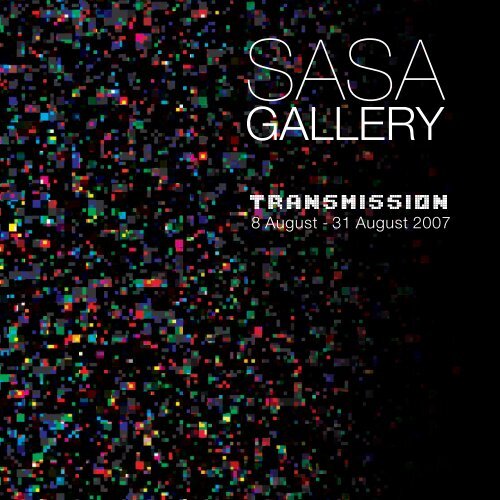
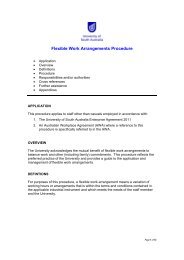
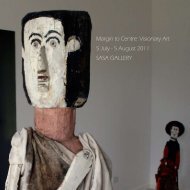
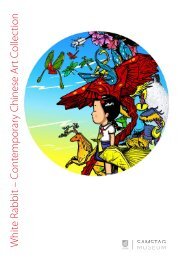
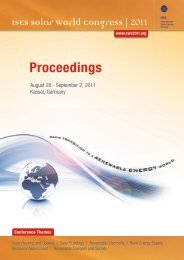
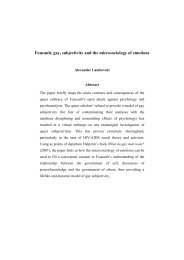
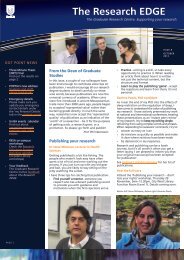
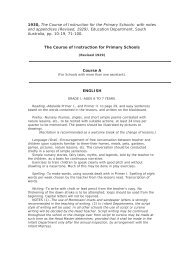
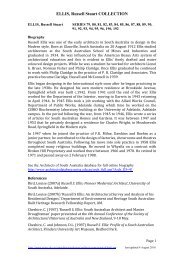

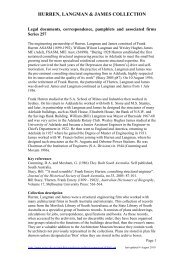
!['The Asian Delegation Chooses […] the Wu-Tang Clan!'—](https://img.yumpu.com/7767765/1/184x260/the-asian-delegation-chooses-the-wu-tang-clan.jpg?quality=85)

